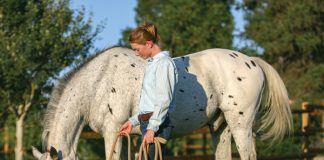Q: My horse just had colic surgery and will be coming home in a few days. I’m sure the hospital (and my regular vet) will give me advice on how to care for him, but this is the first time I (and he!) have been through this and I want to make sure I’m doing everything right. What is your advice for colic aftercare?

A: I completely understand your anxiety, having been through a colic surgery in my own horse not too long ago. The entire process from beginning to end, from the first sign of colic and your regular vet’s on-farm treatments to trailering to the referral center for additional diagnostics and eventual surgery, is extremely stressful for everyone, making it hard to listen to the vet’s explanations and instructions at the time. Thank goodness they’ll send you home with written discharge instructions for you to read when things are a bit more settled.
These discharge instructions usually address general monitoring, caring for the incision, feeding, exercise, and medication, if any. General monitoring includes observing your horse for EDUD or Eating, Drinking, Urinating, and Defecating, as well as making sure he’s BAR (bright, alert, responsive), that he’s regaining any weight he may have lost during this episode, and that he’s not showing any signs of colic. The incision should be inspected daily for signs of infection such as discharge, redness, or excess swelling, as well as “dehiscence,” in which the sutured edges split apart or gape open.
The surgical facility, as part of your horse’s colic aftercare, will have introduced him gradually to his regular diet, feeding small meals frequently, and will give you clear instructions on what and how much to give at what intervals as you continue to restore him to full feed. Depending on what was found during surgery and what the original cause of the colic was determined to be, your horse may or may not return to his regular diet. For example, if an ileal impaction was discovered and his diet had been coastal Bermuda hay, the veterinarians may suggest he be switched to another type of hay that has less of a tendency to cause an obstruction.
A typical timeline for exercise begins with four weeks of stall rest, during which time your horse can be handwalked and handgrazed. This is followed by another four weeks of turnout, alone, in a stall with a small run or paddock attached. At the end of this 60-day or two-month period, if all is still going well, most horses can be given full turnout with other horses. Light longeing and riding is usually permitted at this time, with a gradual return to full training at the 90 day mark.
Personally, I kept a daily journal of my horse’s progress that include the general monitoring above, what he was fed each day and how many manure piles he made, and how long I walked or grazed him. I also wrote down his temperature, pulse, and respiration and other vital signs. This helped me stay on top of any trends and it may help you too!






